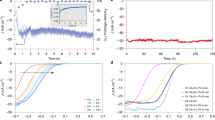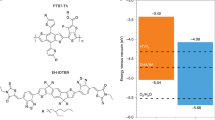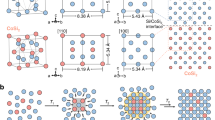Abstract
The production of fuels from sunlight represents one of the main challenges in the development of a sustainable energy system1,2,3,4,5. Hydrogen is the simplest fuel to produce and although platinum and other noble metals are efficient catalysts for photoelectrochemical hydrogen evolution6,7,8,9, earth-abundant alternatives are needed for large-scale use10,11,12,13,14,15. We show that bioinspired molecular clusters based on molybdenum and sulphur evolve hydrogen at rates comparable to that of platinum6. The incomplete cubane-like clusters (Mo3S4) efficiently catalyse the evolution of hydrogen when coupled to a p-type Si semiconductor that harvests red photons in the solar spectrum. The current densities at the reversible potential match the requirement of a photoelectrochemical hydrogen production system with a solar-to-hydrogen efficiency in excess of 10% (ref. 16). The experimental observations are supported by density functional theory calculations of the Mo3S4 clusters adsorbed on the hydrogen-terminated Si(100) surface, providing insights into the nature of the active site.
This is a preview of subscription content, access via your institution
Access options
Subscribe to this journal
Receive 12 print issues and online access
$259.00 per year
only $21.58 per issue
Buy this article
- Purchase on Springer Link
- Instant access to full article PDF
Prices may be subject to local taxes which are calculated during checkout




Similar content being viewed by others
References
Dresselhaus, M. S. & Thomas, I. L. Alternative energy technologies. Nature 414, 332–337 (2001).
Schlapbach, L. & Züttel, A. Hydrogen-storage materials for mobile applications. Nature 414, 353–358 (2001).
Turner, J. A. Sustainable hydrogen production. Science 305, 972–974 (2004).
Lewis, N. S. & Nocera, D. G. Powering the planet: Chemical challenges in solar energy utilization. Proc. Natl Acad. Sci. USA 103, 15729–15735 (2006).
Crabtree, G. & Sarrao, J. The road to sustainability. Phys. World 22, 24–30 (2009).
Dominey, R. N. et al. Improvement of photoelectrochemical hydrogen generation by surface modification of p-type silicon semiconductor photocathodes. J. Am. Chem. Soc. 104, 467–482 (1982).
Heller, A., Aharon-Shalom, E., Bonner, W. A. & Miller, B. Hydrogen-evolving semiconductor photocathodes: Nature of the junction and function of the platinum group metal catalyst. J. Am. Chem. Soc. 104, 6942–6948 (1982).
Khaselev, O. & Turner, J. A. A monolithic photovoltaic-photoelectrochemical device for hydrogen production via water splitting. Science 280, 425–427 (1998).
Maeda, K. et al. Photocatalyst releasing hydrogen from water. Nature 440, 295 (2006).
Hinnemann, B. et al. Biomimetic hydrogen evolution: MoS2 nanoparticles as catalyst for hydrogen evolution. J. Am. Chem. Soc. 127, 5308–5309 (2005).
Zong, X. et al. Enhancement of photocatalytic H2 evolution on CdS by loading MoS2 as co-catalyst under visible light irradiation. J. Am. Chem. Soc. 130, 7176–7177 (2008).
Le Goff, A. et al. From hydrogenases to noble metal-free catalytic nanomaterials for H2 production and uptake. Science 326, 1384–1387 (2009).
Wang, X. C. et al. A metal-free polymeric photocatalyst for hydrogen production from water under visible light. Nature Mater. 8, 76–80 (2009).
Karunadasa, H. I., Chang, C. J. & Long, J. R. A molecular molybdenum-oxo catalyst for generating hydrogen from water. Nature 464, 1329–1333 (2010).
Nann, T. et al. Water splitting by visible light: A nanophotocathode for hydrogen production. Angew. Chem. Int. Ed. 49, 1574–1577 (2010).
Chen, Z. B. et al. Accelerating materials development for photoelectrochemical hydrogen production: Standards for methods, definitions, and reporting protocols. J. Mater. Res. 25, 3–16 (2010).
Grätzel, M. Photoelectrochemical cells. Nature 414, 338–344 (2001).
Lewis, N. S. Toward cost-effective solar energy use. Science 315, 798–801 (2007).
Grey, H. B. Powering the planet with solar fuel. Nature Chem. 1, 7 (2009).
Walter, M. G. et al. Solar water splitting cells. Chem. Rev. 110, 6446–6473 (2010).
Boettcher, S. W. et al. Energy-conversion properties of vapour–liquid–solid grown silicon wire-array photocathodes. Science 327, 185–187 (2010).
Nørskov, J. K. et al. Trends in the exchange current for hydrogen evolution. J. Electrochem. Soc. 152, J23–J26 (2005).
Hansel, A. & Lindblad, P. Towards optimization of cyanobacteria as biotechnologically relevant producers of molecular hydrogen, a clean and renewable energy source. Appl. Microbiol. Biot. 50, 153–160 (1998).
Evans, D. J. & Pickett, C. J. Chemistry and the hydrogenases. Chem. Soc. Rev. 32, 268–275 (2003).
Jaramillo, T. F. et al. Identification of active edge sites for electrochemical H2 evolution from MoS2 nanocatalysts. Science 317, 100–102 (2007).
Jaramillo, T. F. et al. Hydrogen evolution on supported incomplete cubane-type [Mo3S4]4+ electrocatalysts. J. Phys. Chem. C 112, 17492–17498 (2008).
Einsle, O. et al. Nitrogenase MoFe-protein at 1.16 angstrom resolution: A central ligand in the FeMo-cofactor. Science 297, 1696–1700 (2002).
Ferreira, K. N. et al. Architecture of the photosynthetic oxygen-evolving centre. Science 303, 1831–1838 (2004).
Parkin, A. et al. Rapid and efficient electrocatalytic CO2/CO interconversions by carboxydothermus hydrogenoformans CO dehydrogenase I on an electrode. J. Am. Chem. Soc. 129, 10328–10329 (2007).
Sokolov, M. N. et al. in Comprehensive Coordination Chemistry II: From Biology to Nanotechnology, Vol. 4 (eds McCleverty, J. A. & Meyer, T. J.) 761–823 (Elsevier, 2004).
US Department of Energy Hydrogen, Fuel Cells and Infrastructure Technologies Program, Multi-Year Research, Development and Demonstration Plan: Planned Program Activities for 2005–2015 (October 2007).
Acknowledgements
This work was carried out as part of the Catalysis for Sustainable Energy initiative, which is funded by the Danish Ministry of Science, Technology and Innovation. This material is also based on work funded by the Inner Nordic Energy Research Program (09-064270), the Danish Agency for Science Technology and Innovation (FTP 10-080861) and the US Department of Energy, Office of Basic Energy Science. The Center for Individual Nanoparticle Functionality is funded by the Danish National Research Foundation and the Center for Atomic-scale Materials Design is funded by the Lundbeck Foundation.
Author information
Authors and Affiliations
Contributions
Y.H. and P.C.K.V. fabricated the electrodes, carried out electrochemistry experiments and hydrogen measurements. C.D.D., T.P. and O.H. designed Si pillars; M.E.B. and J.R. did the DFT calculations. K.H. synthesized the Mo3S4 clusters; L.B. and A.M.S. measured XPS and analysed the data. B.L.A., S.D., J.K.N. and I.C. conceived the project, supervised the research work and discussed the results. All authors contributed to the paper writing.
Corresponding author
Ethics declarations
Competing interests
The authors declare no competing financial interests.
Supplementary information
Supplementary Information
Supplementary Information (PDF 1312 kb)
Supplementary Movie
Supplementary Movie (MOV 4983 kb)
Rights and permissions
About this article
Cite this article
Hou, Y., Abrams, B., Vesborg, P. et al. Bioinspired molecular co-catalysts bonded to a silicon photocathode for solar hydrogen evolution. Nature Mater 10, 434–438 (2011). https://doi.org/10.1038/nmat3008
Received:
Accepted:
Published:
Issue Date:
DOI: https://doi.org/10.1038/nmat3008
This article is cited by
-
Stable solar water splitting with wettable organic-layer-protected silicon photocathodes
Nature Communications (2022)
-
Modulation to favorable surface adsorption energy for oxygen evolution reaction intermediates over carbon-tunable alloys towards sustainable hydrogen production
Materials for Renewable and Sustainable Energy (2022)
-
Low-dimensional non-metal catalysts: principles for regulating p-orbital-dominated reactivity
npj Computational Materials (2021)
-
3D ordered nanoelectrodes for energy conversion applications: thermoelectric, piezoelectric, and electrocatalytic applications
Journal of the Korean Ceramic Society (2021)
-
Superb water splitting activity of the electrocatalyst Fe3Co(PO4)4 designed with computation aid
Nature Communications (2019)



